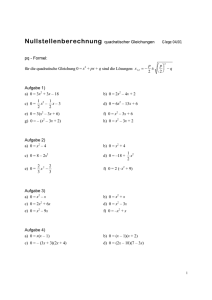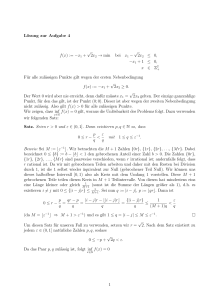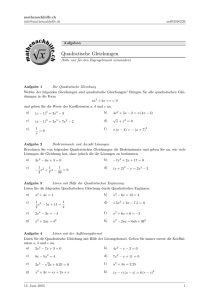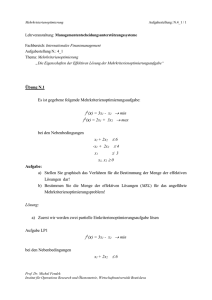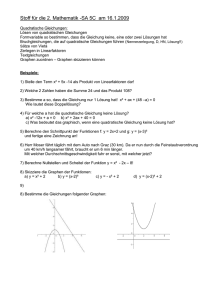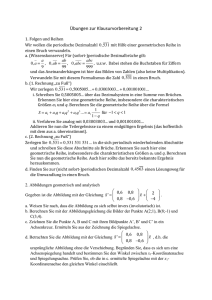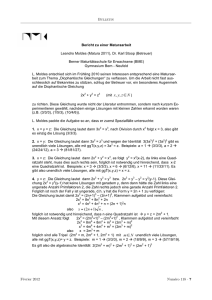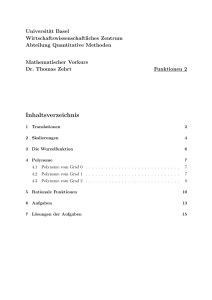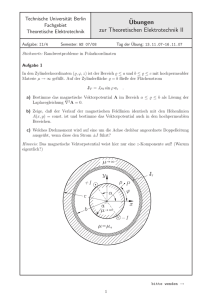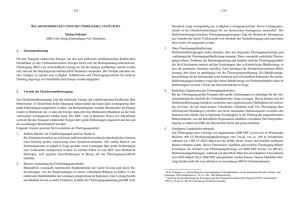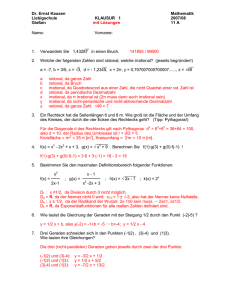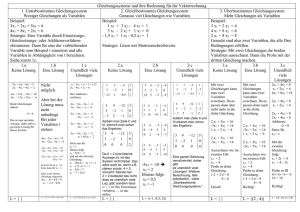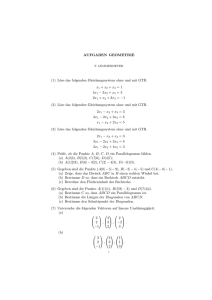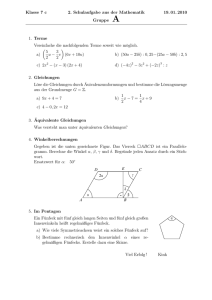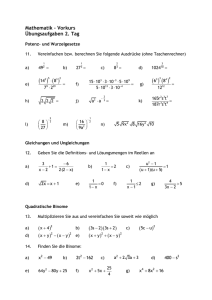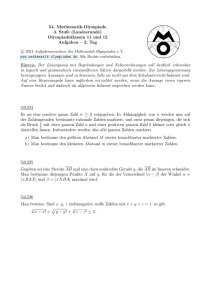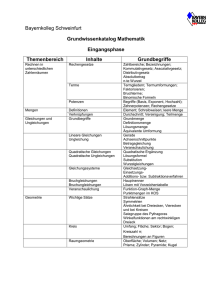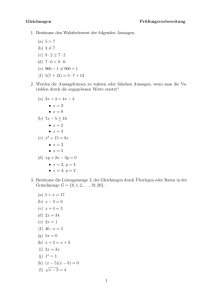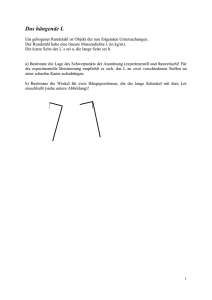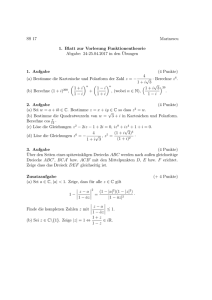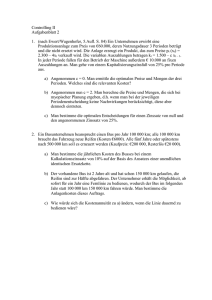Spezielle quadratische und andere Gleichungen 1. Bestimme die
Werbung
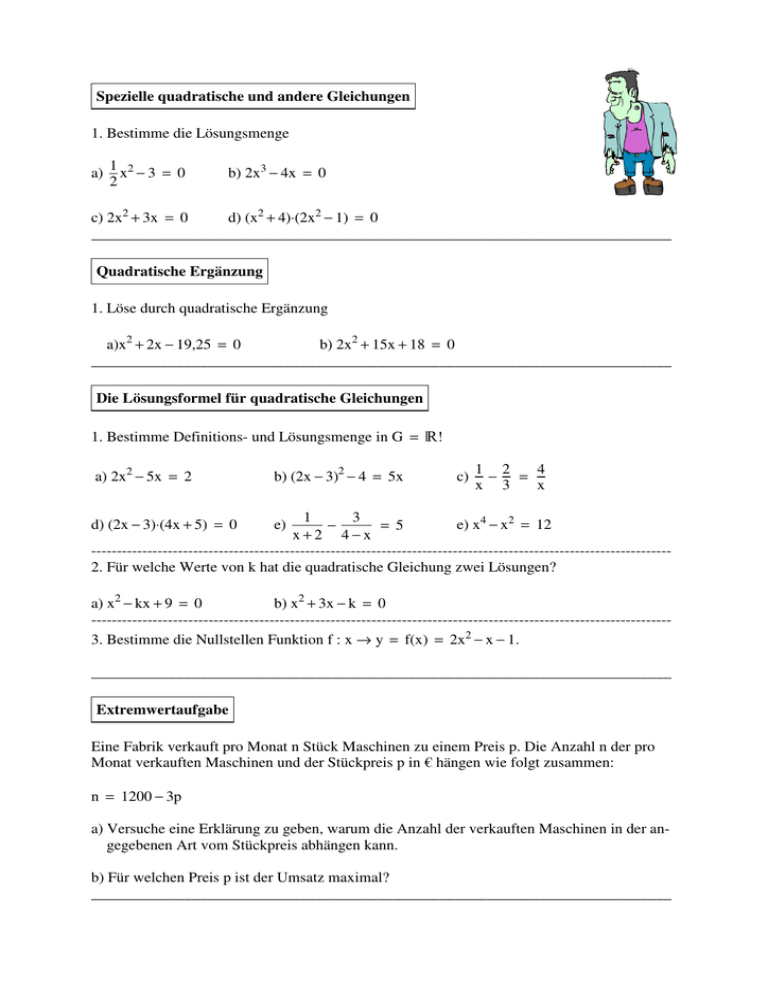
Spezielle quadratische und andere Gleichungen
1. Bestimme die Lösungsmenge
a)
1 2
x −3 = 0
2
b) 2x3 − 4x = 0
c) 2x2 + 3x = 0
d) (x2 + 4)⋅(2x2 − 1) = 0
___________________________________________________________________________
Quadratische Ergänzung
1. Löse durch quadratische Ergänzung
a)x2 + 2x − 19,25 = 0
b) 2x2 + 15x + 18 = 0
___________________________________________________________________________
Die Lösungsformel für quadratische Gleichungen
1. Bestimme Definitions- und Lösungsmenge in G = R!
a) 2x2 − 5x = 2
b) (2x − 3)2 − 4 = 5x
c)
1 2
4
− =
x 3
x
3
1
e) x4 − x2 = 12
−
= 5
x+2 4−x
-----------------------------------------------------------------------------------------------------------------2. Für welche Werte von k hat die quadratische Gleichung zwei Lösungen?
d) (2x − 3)⋅(4x + 5) = 0
e)
a) x2 − kx + 9 = 0
b) x2 + 3x − k = 0
-----------------------------------------------------------------------------------------------------------------3. Bestimme die Nullstellen Funktion f : x → y = f(x) = 2x2 − x − 1.
___________________________________________________________________________
Extremwertaufgabe
Eine Fabrik verkauft pro Monat n Stück Maschinen zu einem Preis p. Die Anzahl n der pro
Monat verkauften Maschinen und der Stückpreis p in € hängen wie folgt zusammen:
n = 1200 − 3p
a) Versuche eine Erklärung zu geben, warum die Anzahl der verkauften Maschinen in der angegebenen Art vom Stückpreis abhängen kann.
b) Für welchen Preis p ist der Umsatz maximal?
___________________________________________________________________________
Lineare Gleichungssysteme
1. Bestimme die Funktionsgleichung der Parabel, die durch die drei Punkte A − 2 | − 3,
B1 | 1,5 und C2 | 5
-----------------------------------------------------------------------------------------------------------------2. Bestimme x, y und z.
x+y+z = 6
(1)
(2) 2x − y + z = 4
(3)3x + 2y − 2z = 4
-----------------------------------------------------------------------------------------------------------------Faktorisisierungssatz
1. Bestimme die Defintionsmenge des Terms in G = R und vereinfache.
2x − 4
4x2 − 1
x2 − 2x
T(x)
=
T(x)
=
b)
c)
2x2 − 6x + 4
x2 + x − 6
2x2 + x − 1
___________________________________________________________________________
a) T(x) =
Spezielle quadratische und andere Gleichungen
1. a)
1 2
x −3 = 0
2
⇔
1 2
x = 3
2
⇔
x2 = 6
b) 2x3 − 4x = 0 ⇔ x⋅(2x2 − 4) = 0
x = 0 ∨ x = − 2 ∨ x =
⇔
c) 2x2 + 3x = 0
⇔
⇔
x = − 6 ∨ x =
6
⇔
x = 0 ∨ 2x2 − 4 = 0
⇔
x = 0 ∨ 2x + 3 = 0 ⇔ x = 0 ∨ x = −
2
x⋅(2x + 3) = 0
3
2
1
1
∨ x =
2
2
___________________________________________________________________________
d) (x2 + 4)⋅(2x2 − 1) = 0
⇔
x2 + 4 = 0 ∨ 2x2 − 1 = 0
⇔ x = −
Quadratische Ergänzung
1. a) x2 + 2x − 19,25 = 0
⇔
⇔
x2 + 2x + 12 = 19,25 + 12
x + 1 = − 4,5 ∨ x + 1 = 4,5
b) 2x2 + 15x + 18 = 0 : 2
⇔
x2 +
⇔
⇔
x2 +
⇔
(x + 1)2 = 20,25
x = − 5,5 ∨ x = 3,5
15
x+9 = 0
2
15
15 2
15 2
x+( ) = −9+( )
2
4
4
⇔
(x +
15 2
81
) =
4
16
⇔
x+
15
9
15
9
= −
∨ x+
=
4
4
4
4
⇔ x = − ∨ x = −
3
2
___________________________________________________________________________
Die Lösungsformel für quadratische Gleichungen
1. a) 2x2 − 5x = 2
⇔
b) (2x − 3)2 − 4 = 5x
2x2 − 5x − 2 = 0 D = ( − 5)2 − 4⋅2⋅( − 2) = 41
⇔
4x2 − 12x + 9 − 4 = 5x
D = 172 − 4⋅4⋅5 = 209 x =
c)
1 2
4
− =
⋅3x
x
x 3
⇔
⇔
4x2 − 17x + 5 = 0
17 − 209
17 + 209
∨ x =
8
8
3 − 2x = 12
⇔
x = − 4,5
3
5
∨ x = −
2
4
----------------------------------------------------------------------------------------------------------------2. a) Bedingung:D = ( − k)2 − 4⋅1⋅9 = k2 − 36 > 0 ⇔ k2 > 36 ⇔ k > 6 ∨ k < − 6
d) (2x − 3)⋅(4x + 5) = 0
⇔
2x − 3 = 0 ∨ 4x + 5 = 0 ⇔
x =
9
4
-----------------------------------------------------------------------------------------------------------------3. a) f(x) = 2x2 − x − 1 = 0 D = ( − 1)2 − 4⋅2⋅( − 1) = 9
b) Bedingung:D = 32 − 4⋅1⋅( − k) > 0
⇔
9 + 4k > 0
⇔
k> −
1− 9
1
1+ 9
= −
∨ x =
= 1
4
2
4
___________________________________________________________________________
x =
Extremwertaufgabe
a) Je höher der Preis, desto weniger Maschinen werden verkauft.
b) Zielgröße: U(p) = (1200 − 3p)⋅p = 1200p − 3p2 = − 3p2 + 1200
Scheitelbestimmung:
− 3p2 + 1200 = − 3⋅(p2 − 400p + 2002 − 2002) = − 3⋅(p − 200)2 + 120000
Bei einemn Preis von 200 € erz ielt man den größten Umsatz. Er beträgt 120000 €.
___________________________________________________________________________
Lineare Gleichungssysteme
1. Ansatz: y = ax2 + bx + c
3
(1)
4a − 2b + c =
(1) + (2)3a − 3b = 1,5 ⇒ a − b = 0,5 (4)
(2) a + b + c = 1,5
(5)
(3) − (2) 3a + b = 3,5
(3)4a + 2b + c =
5
4a =
4
(4) + (5)
(6) in (5) 3 + b = 3,5
(6) und (7) in (3) 4 + 1 + c =
5
⇒ a = 1 (6)
⇒ b = 0,5 (7)
⇒ c = 0
y = x2 + 0,5x
-----------------------------------------------------------------------------------------------------------------2. Bestimme x, y und z.
x+y+z = 6
(1)
a) (2) 2x − y + z = 4
(3)3x + 2y − 2z = 6
(4)
(1) + (2)3x + 2z = 10
7x
14
(3) + 2⋅(2)
=
⇒ x = 2 (5)
(5) in (4) 3⋅2 + 2z = 10 ⇒ z = 2
(5) + (6) in (1)2 + y + 2 = 6 ⇒ y = 2
-----------------------------------------------------------------------------------------------------------------Faktorisisierungssatz
1. Bestimme die Defintionsmenge des Terms in G = R und vereinfache.
Lösungsformel
a) x + x − 6 = 0
2
⇒
x = −3 ∨ x = 2
Also ist D = R\{ − 3; 2}.
T(x) =
x2 − 2x
x⋅(x − 2)
x
=
=
2
(x − 2)⋅(x + 3)
x+3
x +x−6
Lösungsformel
a) 2x2 − 6x + 4 = 0
⇒
x = 1 ∨ x = 2
Also ist D = R\{1; 2}.
T(x) =
2⋅(x − 2)
1
2x − 4
=
=
2⋅(x − 1)⋅(x − 2)
x−1
2x − 6x + 4
2
Lösungsformel
c) 2x2 + x − 1 = 0
⇒
Also ist D = R\{ − 1;
x = −1 ∨ x =
1
2
1
}.
2
4x2 − 1
(2x − 1)⋅(2x + 1)
(2x − 1)⋅(2x + 1)
2x + 1
=
=
=
2
2⋅(x − 0,5)(x + 1)
(2x − 1)(x + 1)
x+1
2x + x − 1
___________________________________________________________________________
T(x) =
